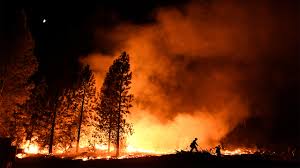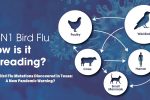California wildfires are a recurring disaster, causing devastation across communities. These fires not only destroy homes and claim lives but also lead to a significant public health crisis that extends far beyond the immediate vicinity of the flames. Smoke and particulate matter released during these wildfires can drift across vast distances, impacting the health of people living hundreds or even thousands of miles away. This article explores the effects of wildfire smoke on health, the science behind its impact, and actionable steps to protect yourself, no matter where you live.
The Immediate Impact of California Wildfires
In the current wildfire season, Southern California has been severely affected. Tens of thousands of residents have evacuated, at least ten lives have been lost, and entire neighborhoods have been reduced to ashes. Governor Gavin Newsom has declared a state of emergency to address the crisis.
While those living near the wildfires experience the most immediate consequences, the dangers don’t end there. The air quality in areas close to the fires has already deteriorated significantly. However, as the fires continue to burn and winds shift, experts predict that regions farther away will also experience the fallout.
Why Wildfire Smoke is a Health Hazard
Wildfire smoke contains a mixture of gases and fine particulate matter (PM) that can harm health. According to the Centers for Disease Control and Prevention (CDC), this smoke is made up of carbon monoxide, carbon dioxide, hydrocarbons, benzene, acrolein, aldehydes, and other hazardous compounds. These pollutants pose a serious risk to people’s respiratory and cardiovascular health.
Short-Term Health Effects
- Respiratory Irritation: Smoke can irritate the airways, causing coughing, wheezing, and shortness of breath.
- Heart Complications: Particulate matter in the air can lead to increased blood pressure, arrhythmias, and even sudden cardiac events.
- Exacerbation of Chronic Conditions: Individuals with asthma, chronic obstructive pulmonary disease (COPD), or other respiratory conditions are particularly vulnerable to worsening symptoms.
Long-Term Health Risks
Prolonged exposure to wildfire smoke can result in:
- Decreased lung function over time.
- Chronic cardiovascular issues, similar to those seen in heart disease patients.
- Development of new respiratory conditions, particularly in children and the elderly.
The Reach of Wildfire Smoke
One of the most concerning aspects of wildfire smoke is its ability to travel. Studies have shown that smoke from wildfires can drift thousands of miles, affecting air quality in distant regions. For example, in June 2023, smoke from wildfires in Western Canada impacted cities along the U.S. East Coast, leading to a 20% increase in hospital visits for heart and lung issues in Baltimore.
How Far Can the Smoke Travel?
Dr. Reynold Panettieri, a researcher at Rutgers University, explains that particulate matter from wildfires can travel across vast distances depending on wind patterns. Although it’s unlikely for smoke from California fires to cross the Rocky Mountains, neighboring states and regions are still at significant risk.
Dr. Brian Christman from Vanderbilt Medicine adds that while short-term exposure to wildfire smoke might not cause severe issues for healthy individuals, those with underlying conditions should remain vigilant, even if they live far from the affected areas.
How to Stay Safe from Wildfire Smoke
Whether you live near the wildfire zone or hundreds of miles away, taking precautions to protect your health is crucial. Here are some expert recommendations:
Monitor Air Quality
- Use tools like the National Weather Service’s air quality index or the AirNow app to check local air quality conditions.
- Pay attention to alerts, especially if you or your family members have preexisting health conditions.
Stay Indoors
- When air quality is poor, minimize outdoor activities and keep windows and doors shut.
- Use central air conditioning systems with high-efficiency filters to maintain cleaner indoor air.
- Invest in portable air purifiers with HEPA filters for additional protection.
Limit Outdoor Exposure
- Avoid strenuous outdoor activities during days of poor air quality.
- Wear a high-quality N95 mask if you need to be outside, particularly in areas close to the wildfire zones.
Watch for Symptoms
Be vigilant about changes in your health, including:
- Difficulty breathing or shortness of breath.
- Persistent coughing or wheezing.
- Rapid or irregular heartbeat.
- Fatigue or dizziness.
Seek medical attention if you notice any of these symptoms, especially during extended periods of poor air quality.
The Special Risk for Vulnerable Populations
Certain groups of people are at higher risk from wildfire smoke:
- Children: Their smaller airways are more prone to irritation, leading to breathing difficulties.
- Elderly Individuals: Age-related health conditions can worsen due to smoke exposure.
- Pregnant Women: Exposure to pollutants in wildfire smoke may impact both the mother and the unborn child.
- People with Preexisting Conditions: Those with asthma, COPD, heart disease, or diabetes are more likely to experience severe complications.
The Future of Wildfires and Public Health
As wildfires become more frequent and intense due to climate change, addressing their public health impacts is more critical than ever. Governments and communities must prioritize wildfire management, develop better early-warning systems, and educate the public on protecting themselves from smoke exposure.
Additionally, long-term solutions, such as improving infrastructure to reduce emissions and investing in renewable energy, can help combat the root causes of climate change, which exacerbates wildfire risks.
Conclusion
The health impact of California wildfires extends far beyond the immediate area of destruction. Smoke and particulate matter can travel vast distances, posing significant risks to people’s respiratory and cardiovascular systems. By staying informed about air quality, taking precautions to limit exposure, and monitoring health symptoms, individuals can reduce the risks associated with wildfire smoke.
While wildfires remain an inevitable natural disaster, proactive measures can help mitigate their effects on human health. Protecting yourself and your loved ones requires awareness, preparation, and collective action to address the broader environmental challenges contributing to these fires.
Disclaimer – Our editorial team has thoroughly fact-checked this article to ensure its accuracy and eliminate any potential misinformation. We are dedicated to upholding the highest standards of integrity in our content.





More Stories
California Wildfires: A Closer Look at the Health Impact Across the U.S.
California Wildfires: A Closer Look at the Health Impact Across the U.S.
California Wildfires: A Closer Look at the Health Impact Across the U.S.